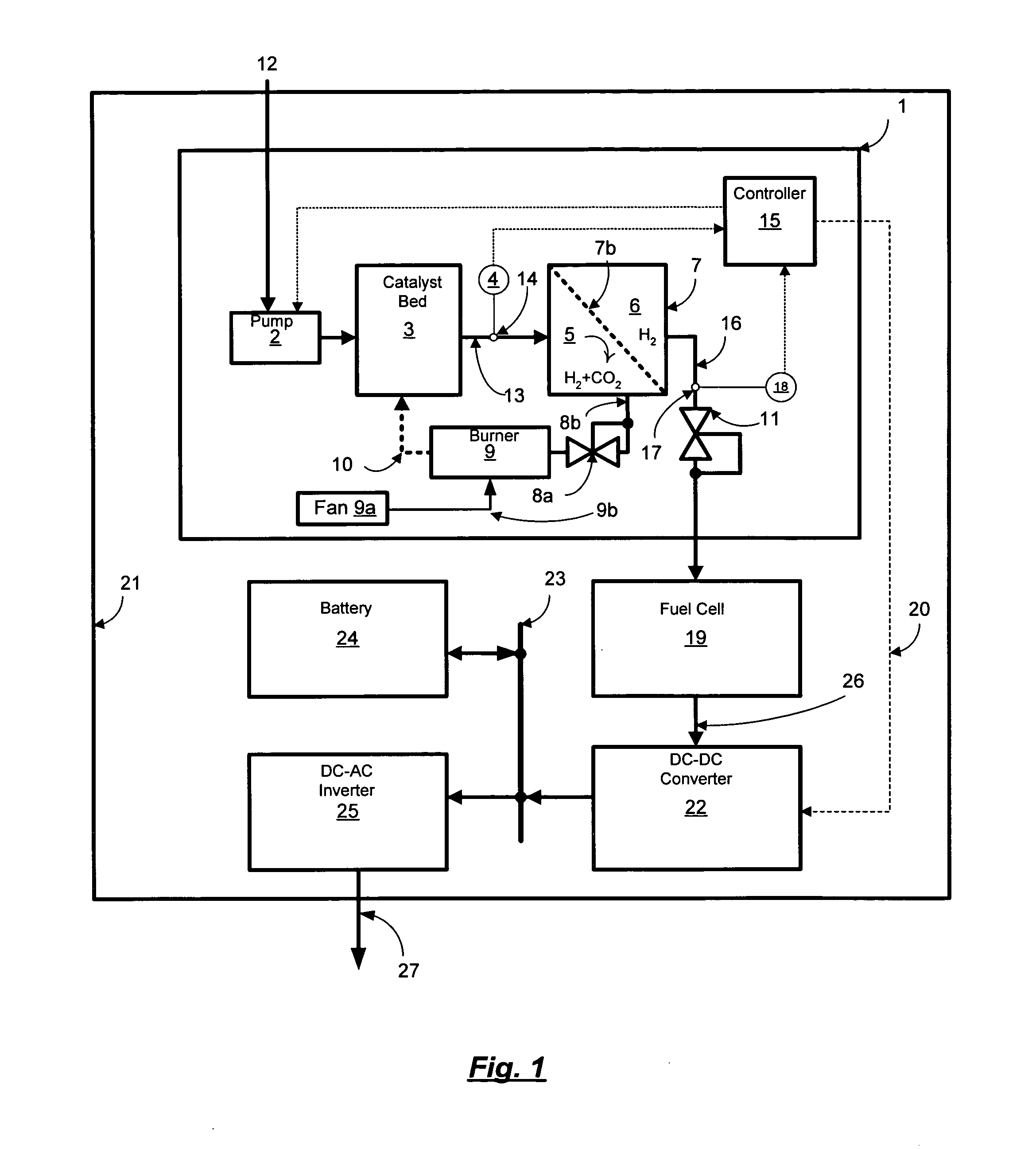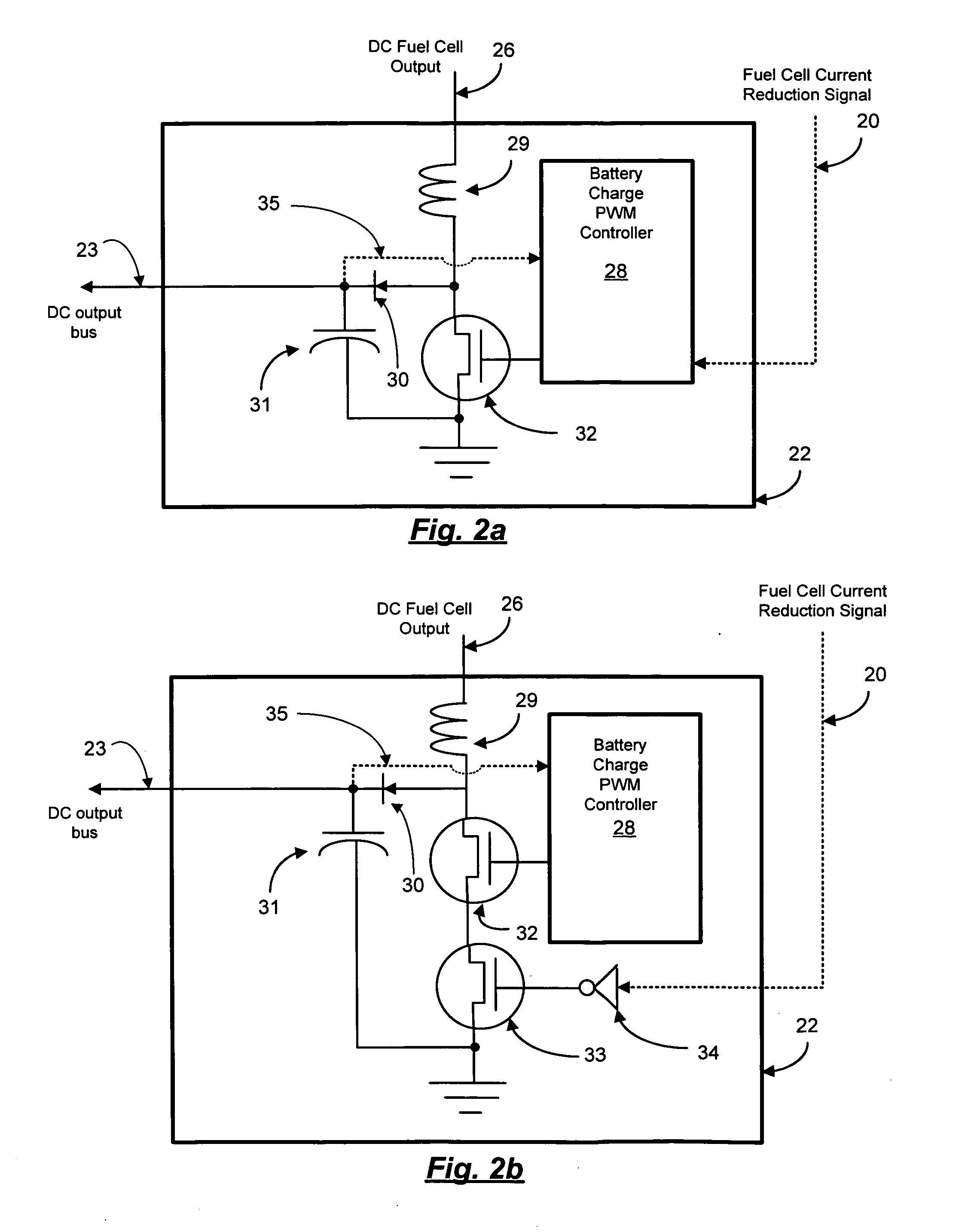Reformer and fuel cell system control and method of operation
a fuel cell and system control technology, applied in the direction of sustainable manufacturing/processing, instruments, physical/chemical process catalysts, etc., can solve the problems of hydrogen pressure exceeding safety limits, pressure dropping below the recommended limits, and the output pressure of the membrane will generally vary too much, so as to achieve the effect of lowering the current output of the fuel cell
- Summary
- Abstract
- Description
- Claims
- Application Information
AI Technical Summary
Benefits of technology
Problems solved by technology
Method used
Image
Examples
experiment 1
[0050] Experiment 1
[0051] A Genesis Fueltech model GT-8 hydrogen purification reformer was used to supply hydrogen to an Avista Labs (Spokane, Wash.) SR-12 fuel cell. The reformer as tested was capable of supplying over 6 standard liters of hydrogen per minute. The reformer control system utilized an industrial programmable ladder logic controller coupled to a hydrogen output pressure transducer, thermocouples for measuring the temperature exiting the catalyst bed and palladium-alloy membrane, and an AC solenoid pump for injecting pressurized methanol / water mix into the reformer. The pump was controlled by periodically turning it on for short periods to charge the reformer with a pulse of methanol / water. The proprietary reforming catalyst required a temperature of approximately 360-425° C. for high conversion of the methanol and water into hydrogen and carbon dioxide. The minimum hydrogen output pressure setpoint was 3 psig, with an upper limit controlled by a pressure regulator. Th...
experiment 2
[0055] Experiment 2
[0056] A Genesis Fueltech GT-8, as described above, was connected to an Hcore-500 fuel cell (H-Power, Inc.). The output of the fuel cell was tested with an adjustable load bank. Once the reformer was warmed up, the fuel cell was brought on-line, using the hydrogen produced by the reformer. In the minimal load condition, the catalyst temperature was maintained at a minimum of about 360-380° C. by increasing the pump rate to prevent cooling below this temperature.
[0057] Once the fuel cell was ready, the load was changed from 0 to 400 watts with a unit step increase. The hydrogen pressure momentarily dropped below 3 psig, but was restored within approximately 3 seconds as the reformer controller increased the pump rate for the methanol / water feedstock. The reformer was able to maintain the 400 watt consumption rate in the steady state, since the catalyst bed was kept above the minimum temperature needed for high production. The calculated hydrogen consumption at the...
experiment 3
[0058] Experiment 3
[0059] A Genesis Fueltech model 20L reformer, rated at an output of 20 standard liters per minute of hydrogen at a minimum output pressure of 5 psig, was configured with an output pressure regulator and flow meter for transient testing. In this particular case, referring to FIG. 1, the output pressure regulator 11 was physically external to reformer enclosure 1, with the hydrogen vented to ambient rather than traveling to a fuel cell. Pressure sensing 18 for control of the reformer was internal to reformer enclosure 1, sensing the pressure on pressure regulator input line 16. The external pressure regulator (Marshall Gas Controls, Inc., model 350) was set to an output pressure of 5 psig, and the flow meter (Advanced Specialty Gas Equipment, model VFM7965B-3B) was set for a flow of 20.5 slm of hydrogen. The output flow rate was verified with water displacement testing.
[0060] The reformer was set with zero hydrogen output flow and allowed to stabilize. The controll...
PUM
| Property | Measurement | Unit |
|---|---|---|
| Temperature | aaaaa | aaaaa |
| Temperature | aaaaa | aaaaa |
| Temperature | aaaaa | aaaaa |
Abstract
Description
Claims
Application Information
 Login to View More
Login to View More - R&D
- Intellectual Property
- Life Sciences
- Materials
- Tech Scout
- Unparalleled Data Quality
- Higher Quality Content
- 60% Fewer Hallucinations
Browse by: Latest US Patents, China's latest patents, Technical Efficacy Thesaurus, Application Domain, Technology Topic, Popular Technical Reports.
© 2025 PatSnap. All rights reserved.Legal|Privacy policy|Modern Slavery Act Transparency Statement|Sitemap|About US| Contact US: help@patsnap.com



